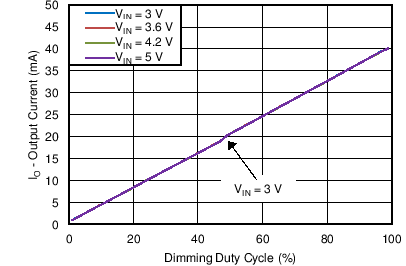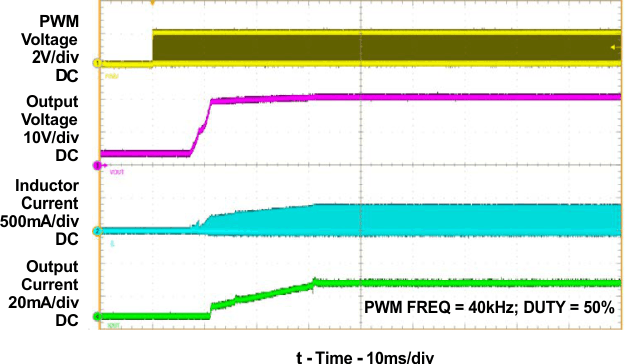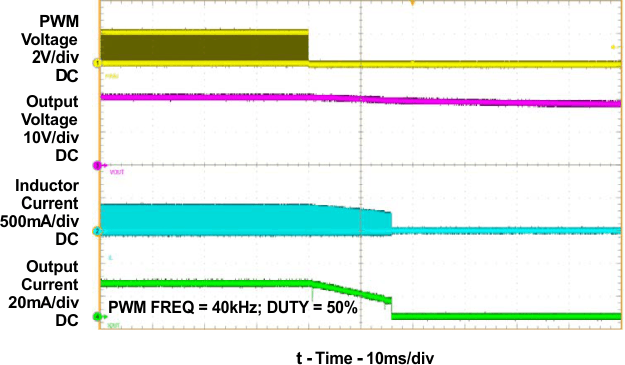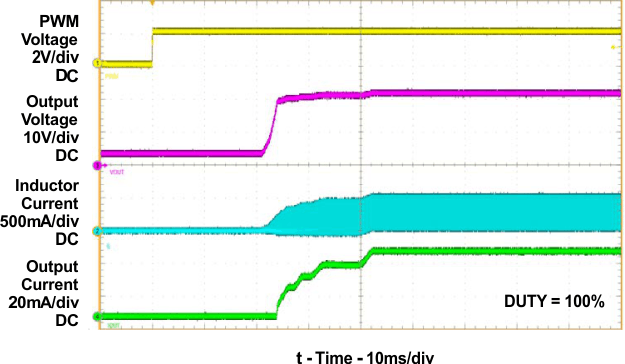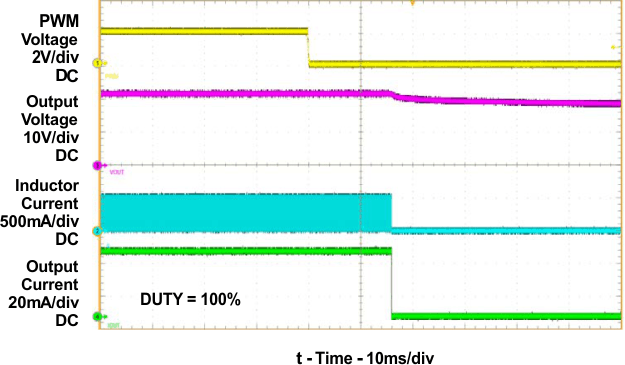SLVSBQ2D January 2013 – May 2016 TPS61163
PRODUCTION DATA.
- 1 Features
- 2 Applications
- 3 Description
- 4 Revision History
- 5 Device Comparison Table
- 6 Pin Configuration and Functions
- 7 Specifications
- 8 Detailed Description
- 9 Application and Implementation
- 10Power Supply Recommendations
- 11Layout
- 12Device and Documentation Support
- 13Mechanical, Packaging, and Orderable Information
Package Options
Mechanical Data (Package|Pins)
- YFF|9
Thermal pad, mechanical data (Package|Pins)
Orderable Information
7 Specifications
7.1 Absolute Maximum Ratings
over operating free-air temperature range (unless otherwise noted)(1)| MIN | MAX | UNIT | ||
|---|---|---|---|---|
| Voltage(2) | VIN, EN, PWM, IFB1, IFB2 | –0.3 | 7 | V |
| COMP, ISET | –0.3 | 3 | ||
| SW | –0.3 | 40 | ||
| PD | Continuous power dissipation | See Thermal Information | ||
| TJ | Operating junction temperature | –40 | 150 | °C |
| Tstg | Storage temperature | –65 | 150 | |
(1) Stresses beyond those listed under Absolute Maximum Ratings may cause permanent damage to the device. These are stress ratings only, which do not imply functional operation of the device at these or any other conditions beyond those indicated under Recommended Operating Conditions. Exposure to absolute-maximum-rated conditions for extended periods may affect device reliability.
(2) All voltage values are with respect to network ground terminal.
7.2 ESD Ratings
| VALUE | UNIT | |||
|---|---|---|---|---|
| V(ESD) | Electrostatic discharge | Human-body model (HBM), per ANSI/ESDA/JEDEC JS-001(1) | ±2000 | V |
| Charged-device model (CDM), per JEDEC specification JESD22-C101(2) | ±750 | |||
| Machine model (MM) | 200 (max) | |||
(1) JEDEC document JEP155 states that 500-V HBM allows safe manufacturing with a standard ESD control process.
(2) JEDEC document JEP157 states that 250-V CDM allows safe manufacturing with a standard ESD control process.
7.3 Recommended Operating Conditions
over operating free-air temperature range (unless otherwise noted)7.4 Thermal Information
| THERMAL METRIC(1) | TPS61163 | UNIT | |
|---|---|---|---|
| YFF (DSBGA) | |||
| 9 PINS | |||
| RθJA | Junction-to-ambient thermal resistance | 107 | °C/W |
| RθJC(top) | Junction-to-case (top) thermal resistance | 0.9 | °C/W |
| RθJB | Junction-to-board thermal resistance | 18.1 | °C/W |
| ψJT | Junction-to-top characterization parameter | 40 | °C/W |
| ψJB | Junction-to-board characterization parameter | 18 | °C/W |
(1) For more information about traditional and new thermal metrics, see the Semiconductor and IC Package Thermal Metrics application report, SPRA953.
7.5 Electrical Characteristics
VIN = 3.6 V, EN = high, PWM = high, IFB current = 20 mA, typical values are at TA = 25°C, and minimum and maximum values are at TA = –40°C to +85°C (unless otherwise noted)| PARAMETER | TEST CONDITIONS | MIN | TYP | MAX | UNIT | |
|---|---|---|---|---|---|---|
| POWER SUPPLY | ||||||
| VIN | Input voltage range | 2.7 | 6.5 | V | ||
| VVIN_UVLO | Undervoltage lockout threshold | VIN falling | 2.2 | 2.3 | V | |
| VIN rising | 2.45 | |||||
| VVIN_HYS | VIN UVLO hysteresis | 100 | mV | |||
| IQ | Operating quiescent current into VIN | Device enable, switching 1.2 MHz and no load VIN = 3.6 V |
1.2 | 2 | mA | |
| ISD | Shutdown current | EN = low | 1 | 2 | µA | |
| EN and PWM | ||||||
| VH | EN Logic high | 1.2 | V | |||
| VL | EN Logic Low | 0.4 | V | |||
| VH | PWM logic high | 1.2 | V | |||
| VL | PWM logic low | 0.4 | V | |||
| RPD | EN pin and PWM pin internal pulldown resistor | 400 | 800 | 1600 | kΩ | |
| tPWM_SD | PWM logic low width to shutdown | PWM high to low | 20 | ms | ||
| tEN_SD | EN logic low width to shutdown | EN high to low | 2.5 | ms | ||
| CURRENT REGULATION | ||||||
| VISET_full | ISET pin voltage | Full brightness | 1.204 | 1.229 | 1.253 | V |
| KISET_full | Current multiplier | Full brightness | 1030 | |||
| IFB_avg | Current accuracy | IISET = 20 μA, D = 100%, 0°C to 70°C | –2% | 2% | ||
| IISET = 20 µA, D = 100%, –40°C to 85°C | –2.3% | 2.3% | ||||
| KM | (IMAX – IAVG) / IAVG | D = 100% | 1% | 2% | ||
| D = 25% | 1% | |||||
| IIFB_max | Current sink max output current | IISET = 35 μA, each IFBx pin | 30 | mA | ||
| POWER SWITCH | ||||||
| RDS(on) | Switch MOSFET on resistance | VIN = 3.6 V | 0.25 | Ω | ||
| VIN = 3 V | 0.3 | |||||
| ILEAK_SW | Switch MOSFET leakage current | VSW = 35 V, TA = 25°C | 1 | µA | ||
| OSCILLATOR | ||||||
| fSW | Oscillator frequency | 1000 | 1200 | 1500 | kHz | |
| Dmax | Maximum duty cycle | Measured on the drive signal of switch MOSFET | 91% | 95% | ||
| BOOST VOLTAGE CONTROL | ||||||
| VIFB_reg | IFBx feedback regulation voltage | IIFBx = 20 mA, measured on IFBx pin which has a lower voltage | 90 | mV | ||
| Isink | COMP pin sink current | 12 | µA | |||
| Isource | COMP pin source current | 5 | µA | |||
| Gea | Error amplifier transconductance | 30 | 55 | 80 | µmho | |
| Rea | Error amplifier output resistance | 45.5 | MΩ | |||
| fea | Error amplifier crossover frequency | 5 pF connected to COMP pin | 1.65 | MHz | ||
| PROTECTION | ||||||
| ILIM | Switch MOSFET current limit | D = Dmax, 0°C to 70°C | 1 | 1.5 | 2 | A |
| ILIM_Start | Switch MOSFET start up current limit | D = Dmax | 0.7 | A | ||
| tHalf_LIM | Time window for half current limit | 5 | ms | |||
| VOVP_SW | SW pin over voltage threshold | 36 | 37.5 | 39 | V | |
| VOVP_IFB | IFBx pin over voltage threshold | Measured on IFBx pin | 4.2 | 4.5 | 4.8 | V |
| VACKNL | Acknowledge output voltage low Open drain, Rpullup = 15 kΩ to VIN(1) |
0.4 | V | |||
| THERMAL SHUTDOWN | ||||||
| Tshutdown | Thermal shutdown threshold | 160 | °C | |||
| Thys | Thermal shutdown hysteresis | 15 | °C | |||
(1) Acknowledge condition active 0, this condition is only applied when the RFA bit is set to 1. To use this feature, master must have an open drain output, and the data line must be pulled up by the master with a resistor load.
7.6 EasyScale Timing Requirements
| MIN | NOM | MAX | UNIT | ||
|---|---|---|---|---|---|
| tes_delay | EasyScale detection delay, measured from EN low to high | 100 | µs | ||
| tes_det | EasyScale detection time, EN pin low time | 260 | µs | ||
| tes_win | EasyScale detection window, easured from EN low to high(1) | 1 | ms | ||
| tstart | Start time of program stream | 2 | µs | ||
| tEOS | End time of program stream | 2 | 360 | µs | |
| tH_LB | High time of low bit (Logic 0) | 2 | 180 | µs | |
| tL_LB | Low time of low bit (Logic 0) | 2 × tH_LB | 360 | µs | |
| tH_HB | High time of high bit (Logic 1) | 2 × tL_HB | 360 | µs | |
| tL_HB | Low time high bit (Logic 1) | 2 | 180 | µs | |
| tvalACKN | Acknowledge valid time | 2 | µs | ||
| tACKN | Duration of acknowledge condition | 512 | µs | ||
(1) To select EasyScale interface, after tes_delay delay from EN low to high, drive EN pin to low for more than tes_det before tes_win expires.
